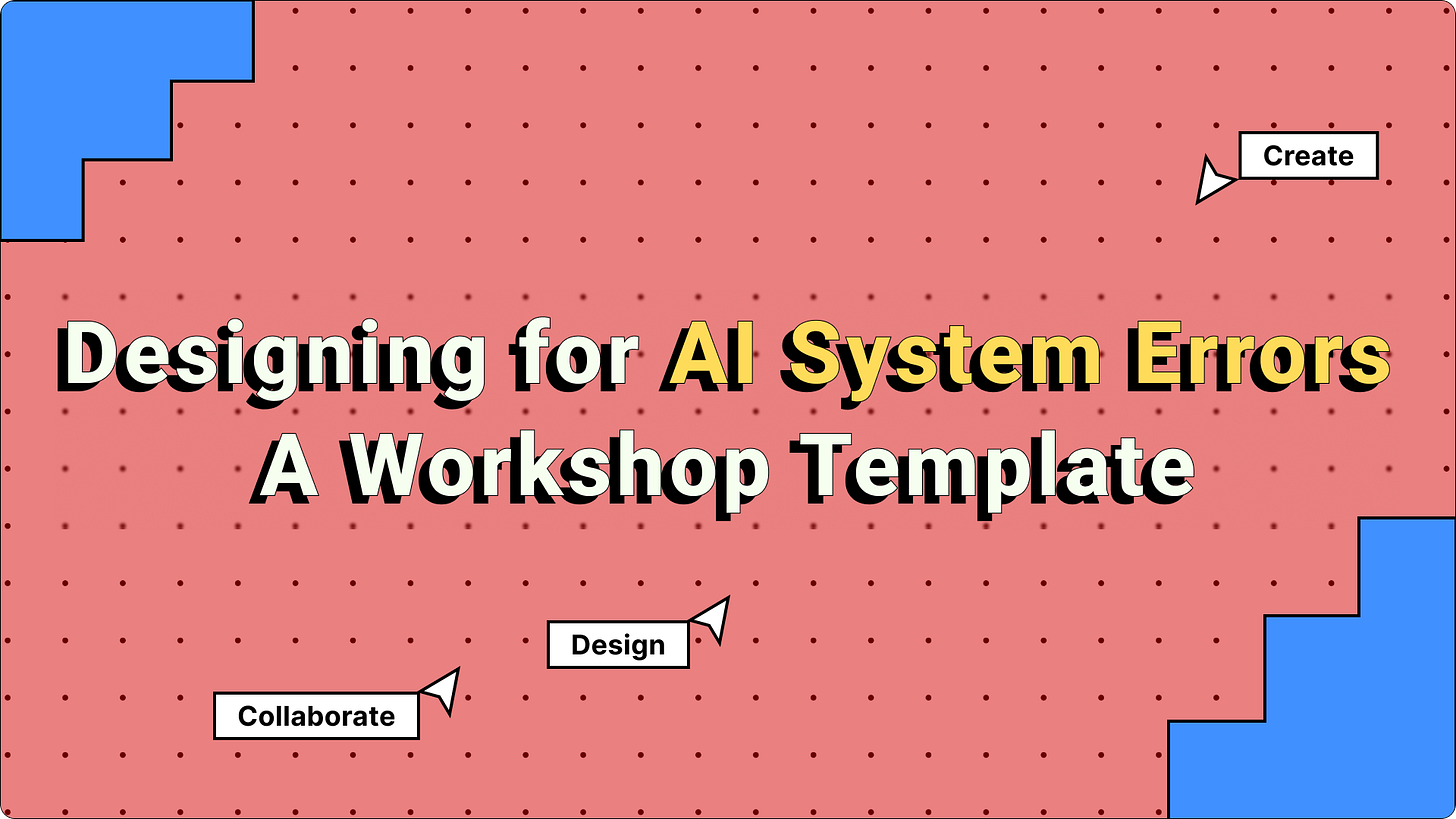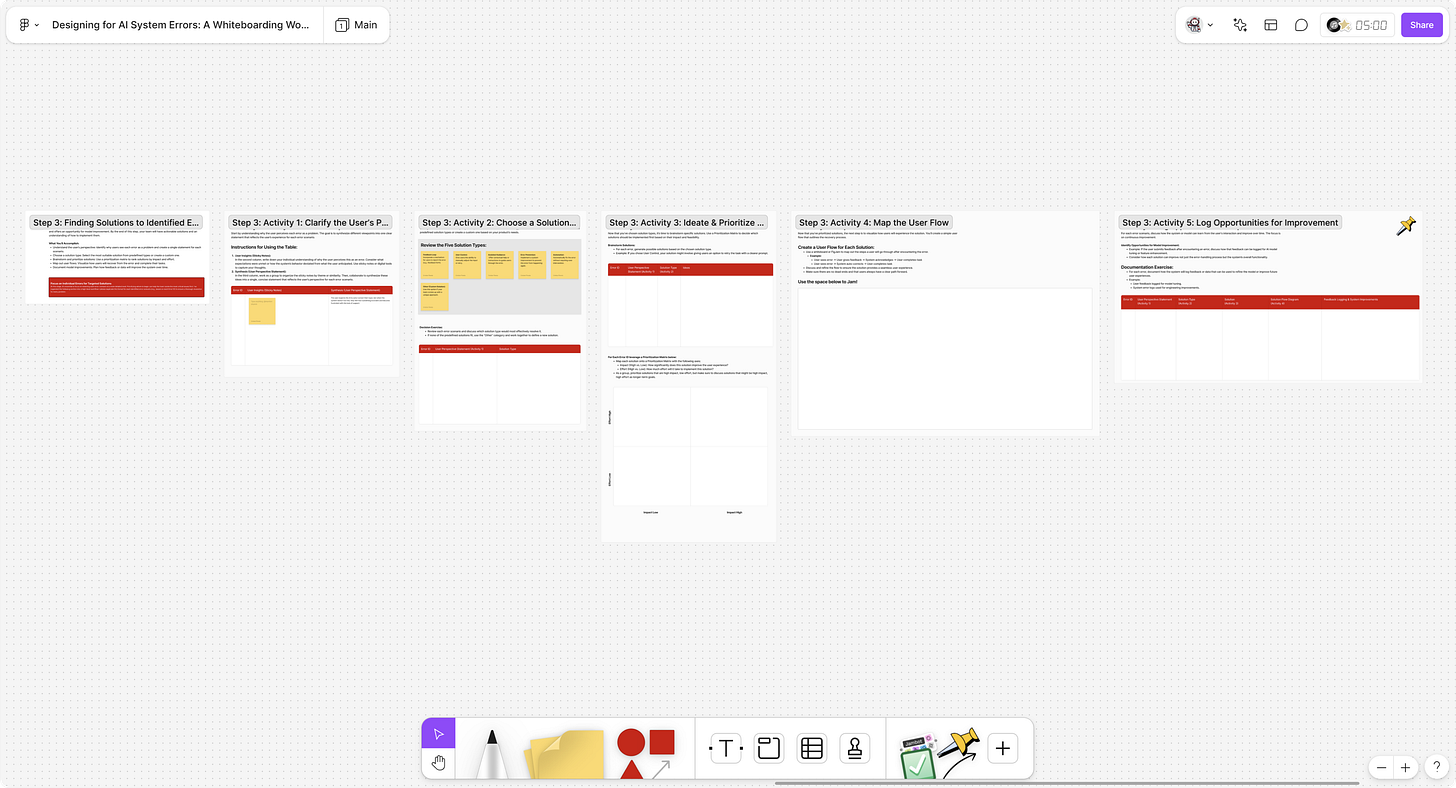Designing for AI Errors: Turning Mistakes into User-Friendly Solutions
Learn key techniques for identifying, addressing, and resolving AI errors while maintaining a user-centered approach. Includes a hands-on Figjam workshop for practical application.
Hi friends!
Is anyone else still thinking about last week’s Meta announcements?! The progress on Meta AI and those Orion glasses—cool, right? You’ve got to love the innovation.
One moment that really stood out to me was when Zuck introduced Meta AI’s new conversational features. He asked the AI assistant how risky it is to do live demos, and the system responded:
“Live demos can be risky, yes. They can be unpredictable, prone to technical issues, and potentially embarrassing. However, they can also be engaging, memorable, and effective in showcasing products or skills. Preparation is key to managing those risks.”
This got me thinking about UX. A key responsibility of UX designers is to anticipate the edge cases that users might encounter. But with AI being such a unique type of product, how do we handle these edge cases, especially when mistakes are inevitable? Whether with machine learning or traditional systems, errors are part of the learning process. But how we design for those errors is what sets user-friendly systems apart.
With this in mind, I created a FREE Figjam workshop for you and your team. It’s designed to guide you through identifying AI errors, understanding their root causes, and brainstorming actionable solutions. You’ll move from strategy to wireframing, and by the end, you’ll have concrete insights you can turn into product improvements. Dropping the link below—check it out Let me know what you think!
➡️ Designing for AI System Errors: A Whiteboarding Workshop Template
If Figjam isn’t your thing, don’t worry! I’ll be covering much of the same content in today’s post, though at a higher level. So, let’s dive into these techniques and learn how to turn errors into moments that strengthen your AI product’s user experience.
Defining Errors & Failure
Before you can design for errors, it’s important to clarify what counts as an "error" or "failure" in your system. Consider that In probabilistic AI systems, users might see failure in places where the AI is actually functioning as intended and this misalignment can create a significant opportunity for user pain points.
What you can do: Set up a time with as many cross functional stakeholders as you can and dedicate this time to collecting canonical error examples. This will set the stage for you to and your team to have a share understanding of potential errors to work toward solutions.
Identifying the Source of Errors
AI systems are complex, and identifying the root cause of an error can be challenging. As a designer, it’s essential to collaborate with your team to establish a process for recognizing and understanding errors. This approach helps you address issues more effectively and improve error-handling experiences.
What you can do: Define error types like system limitations, context misalignment, or input errors using canonical examples. Once sources are identified, collaborate on a plan to resolve them, focusing on feedback loops and improving user control.
Consider these questions to pinpoint root causes:
Did the system misinterpret the user’s input or fail to auto-correct?
Was the user’s habitual action interrupted, causing confusion?
Is the model working with incomplete or unstable data?
Is there confusion over which system is in control, especially during integrations?
Did multiple errors cascade, rendering features unusable?
By addressing these, your team can systematically diagnose errors, create targeted solutions, and improve user control and feedback loops.
Designing a Path Forward
No matter how well-planned, AI systems will experience failure. The goal isn’t to avoid errors but to detect them early and design thoughtful recovery options that improve the system over time.
What you can do: Set up feedback loops that capture and route errors back to your team for refinement. Use multiple sources to track and analyze issues:
In-product feedback tools to capture real-time issues.
Customer service reports that describe problems in detail.
Social media comments highlighting frustrations.
In-product surveys that prompt users for input after errors.
User research like interviews and diary studies to uncover patterns.
Decide which feedback channels suit your team’s resources. Not every channel is feasible, but the right ones will provide valuable insights. Ensure the user experience feels supportive, and that feedback continuously improves the system.
Humanizing the Error Experience
Errors aren’t just technical issues—they’re opportunities to humanize your product. Error messages should reflect humanity, not just machine logic. Be transparent about the system’s limitations and encourage users to continue their journey. Explain how the AI learns from mistakes and how users can help improve it.
When users encounter errors, offer recovery options like retrying, adjusting input, or seeking assistance. Every error message should guide users forward, not leave them stuck.
What you can do:
Return control to the user: Give users intuitive options to regain control and move forward.
Assume subversive behavior: Design failures that are safe and avoid revealing system vulnerabilities.
Ensure suggestions are relevant: Make sure error suggestions help users progress, not just respond to the issue.
Always provide a path forward: Guide users to recovery options without dead ends.
Be transparent: Explain what went wrong and how the system is improving.
Take accountability: Use sincere messaging that acknowledges faults and maintains user trust.
By considering these elements, you can turn error states into moments of connection and trust-building.
The Heart of Learning is built from failure
Learning can't happen without making mistakes, and this is a critical concept for designers working with AI systems. When users encounter errors, it’s an opportunity for dialogue, not frustration. By designing your system with errors in mind, you allow users to see that the AI is a work-in-progress, and this transparency helps keep them engaged.
Designing user-centered error experiences for AI products goes beyond just fixing technical issues. It’s about showing users that you’re listening, that the system is learning, and that their feedback matters. By being transparent, human, and thoughtful in how you manage errors, you can turn mistakes into moments that build trust and improve your product.
What do you think about designing for errors in AI systems? Let me know your thoughts or questions in the comments—I’d love to hear your perspective.
Thank you for reading today’s post!
I hope you enjoyed this week’s issue of “Cristian Talks Product Design.” Your feedback is incredibly valuable and helps me improve and deliver content that matters to you. If you have a minute, it would mean a lot if you could complete this quick 3-question survey!






